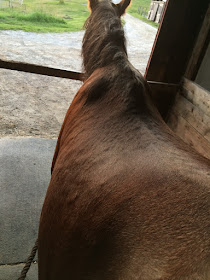The product in question is the NibbleNet Slow Feeder Hay Bag. Mine is the 1.5" hole version, and it comes with smaller holes. It retails for $69.99, so this is not a cheap piece of equipment.
(not my photo)
I have previously experimented with slow feeder hay bags when Tristan was on stall rest from his surgery. I purchased the SmartPak Small Hole Hay Net in the hopes of slowing down his consumption. That didn't last long. It was time-consuming for the barn staff to load, and Tristan loathed it, to the degree that my food-crazy pony would often leave the last bit when it got really difficult to get the hay out. So it's been in storage ever since.
Two winters ago, the barn recommended purchasing the NibbleNets for use in all the stalls; that would help with maintaining more of a free choice hay environment in the stalls, which for us is especially important in the winter, given how cold it gets. I didn't have the funds at the time to purchase this particular brand, so I subbed in my old Classic Equine Top Load Hay Bag. I had two of them; I had purchased them after much deliberation as hay bags for my trailer. Joke's on me, they never worked in the trailer because of the way the manger area was set up, so I always used just a regular cotton hay net. That bag barely lasted the winter - it was a smart design and an attractive bag but it was just not durable at all. I stitched it back together several times but finally gave up on it.
Last January, I made my first purchase at Riding Warehouse during their 20% off sale, and this bag was on the top of my list. I paid $55.16 for it. How has it been since then?
Magic. Okay, that's a little bit of an exaggeration, but WOW, this sucker wears like iron and does exactly what it says on the tin: slows down a horse's rate of eating.
Much to the chagrin of shaggy little roan mustangs.
It does flip over sometimes, but it's easy enough even for the horses to flip back the right way, and for my money, that's extra entertainment value. And there are loops on the bottom and ways you can tie it down more securely if that sort of thing really bothers you.
Thinking I would write this post for today, last night I took a good long look at the hay bag to check for weaknesses, stress points, or wear marks. I found basically none, after 10 months of continual use by a horse who is not easy on his toys.
So despite the higher price tag, I can HIGHLY recommend this hay bag. It durability and usability are worth the cost.


















































